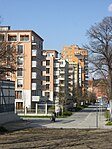Bavaria statue

Bavaria is the name given to a monumental, bronze sand-cast 19th-century statue in Munich, southern Germany. It is a female personification of the Bavarian homeland, and by extension its strength and glory. The statue is part of an ensemble which also includes a hall of fame (Ruhmeshalle) and a stairway. It was commissioned by Ludwig I of Bavaria, with the specific design being chosen by competition. It was cast at the Munich foundry of J.B. Stiglmair between 1844 and 1850 and is the first colossal statue since Classical Antiquity to consist entirely of cast bronze. It was and is up to the present day considered a technological masterpiece. Because of its size it had to be produced in several parts; it is 18.52 metres (60 ft. 9 in.) high and weighs about 87.36 tons. It rests on a stone base which is 8.92 (28 ft.) metres high. An internal circular staircase leads up to a platform in the head, where four openings in the helmet provide a view of the Theresienwiese and downtown Munich.
Excerpt from the Wikipedia article Bavaria statue (License: CC BY-SA 3.0, Authors, Images).Bavaria statue
Hans-Fischer-Straße, Munich St. Paul (Ludwigsvorstadt-Isarvorstadt)
Geographical coordinates (GPS) Address Website Nearby Places Show on map
Geographical coordinates (GPS)
| Latitude | Longitude |
|---|---|
| N 48.130555555556 ° | E 11.545833333333 ° |
Address
Theresienwiese (Oktoberfest)
Hans-Fischer-Straße
80336 Munich, St. Paul (Ludwigsvorstadt-Isarvorstadt)
Bavaria, Germany
Open on Google Maps










